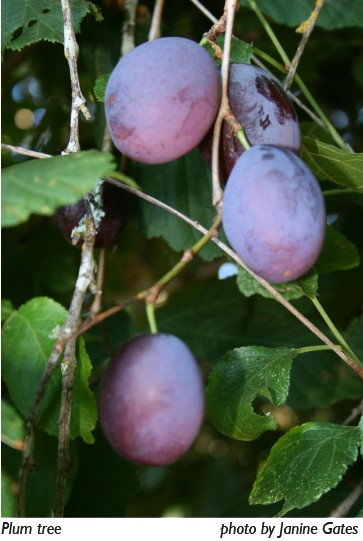Turn Your Lawn into an Edible Forest Gardenby Pat Rasmussen Imagine eating from your own yard: apples, pears, peaches, apricots, plums, figs, blueberries, raspberries, currants, black elderberries, serviceberries, aronia berries, kiwis, green tea, hazelnuts, walnuts, chestnuts, strawberries, cranberries, oyster mushrooms, and perennial vegetables such as Jerusalem artichokes, Good King Henry (a perennial spinach), and corn salad, a tender lettuce that grows year round. Terra Commons is a local non-profit organization helping people in Olympia replace their lawns with edible forest gardens through workshops where volunteers are invited to help install gardens for homeowners, churches, schools, parks, businesses, and neighborhood associations. The workshops provide hands-on experience to teach participants how to design an edible forest garden, plant the fruit and nut trees and berry bushes, sheet mulch the lawn, and inoculate with edible mushrooms. Volunteers can have an edible forest garden planted in their yard or help a neighbor plant one. Beyond the benefits of consuming organic food from a perennial, no-till garden, community members will help solve multiple crises we face collectively: climate change, salmon and orca habitat needs, food security and saving money during times of financial insecurity. Edible forest gardens take carbon from the atmosphere and hold it in trees, plants, roots, and soils. No-till gardening keeps the carbon in the soil. Carbon emissions from transportation are reduced as food is produced and consumed locally. The average food item in a store may travel 2,000 miles or more before it reaches the dinner table. Once established, the edible forest garden needs little water and is self-sustaining like the natural forest it is modeled on, reducing water needs. Trees and other deep-rooted plants pull water and nutrients up from deep in the soil, providing for themselves and other plants in the garden. No fertilizers or pesticides are used, reducing toxins going into salmon streams or rivers and Puget Sound where orcas live. Storm water is filtered and absorbed, reducing run-off. The extra fruits, berries, and vegetables can be dehydrated, canned, or frozen for out-of-season use. Once the edible forest garden is planted, it will provide food for many years into the future, easing the family budget. Edible forest gardens can help create community in our neighborhoods. Neighbors may plan together to share or trade food in the future. Neighborhoods or streets might identify unused spaces to plant walnut, chestnut, and fruit trees that can be shared. A community edible forest garden could be planted and tended, with a picnic table as a gathering spot for neighbors, shaded by fruit trees. Neighbors could do some mapping and make agreements for care and harvest of neighborhood fruit and nut trees that aren't being picked. An unused building could be used as a a communal kitchen for dehydrating and canning fruits and vegetables, shared among neighbors. Imagine what could be done in your neighborhood. Terra Commons has a number of Edible Forest Garden workshops coming up. Please join us by volunteering or providing the site where the edible forest garden is planted. The workshops are generally on weekends, 10 a.m. to 4 p.m. You can check for upcoming dates on our website at: http://www.terracommons.us Or call or e-mail Michael Kelly at 360-339-3329 or mailto:terracommons@gmail.com Pat Rasmussen is co-coordinator of Terra Commons, with Michael Kelly. Rasmussen has spent the past 20 years protecting forests and now is restoring areas disturbed by lawns to food forests that function like natural forests.
Back to Home page. |

